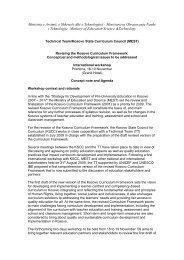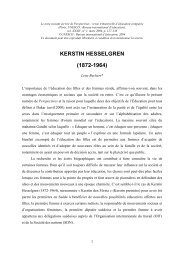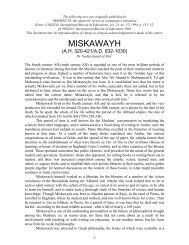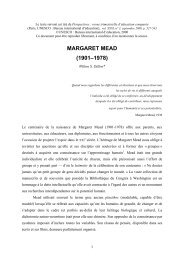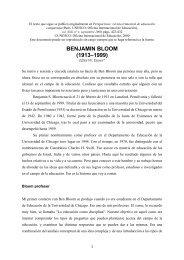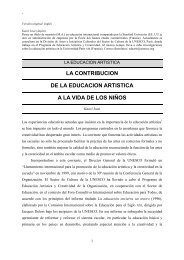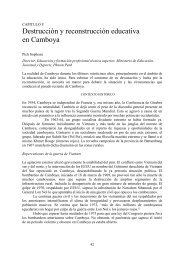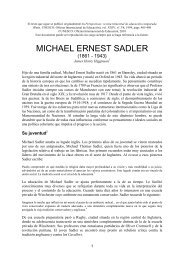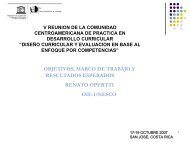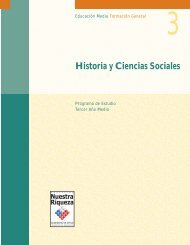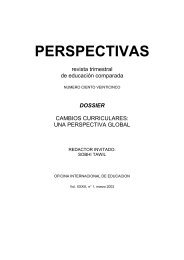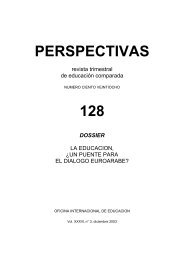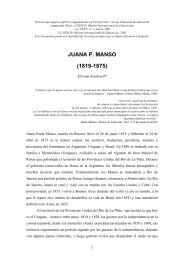Curriculum Change and Social Inclusion - International Bureau of ...
Curriculum Change and Social Inclusion - International Bureau of ...
Curriculum Change and Social Inclusion - International Bureau of ...
You also want an ePaper? Increase the reach of your titles
YUMPU automatically turns print PDFs into web optimized ePapers that Google loves.
1. The first study plans <strong>and</strong> programmes<br />
During the formation periods <strong>of</strong> these systems (the end <strong>of</strong><br />
the nineteenth <strong>and</strong> early twentieth centuries, depending on<br />
the country <strong>of</strong> Latin America to which we refer), the<br />
structure <strong>of</strong> the study plans <strong>and</strong> programmes in the<br />
countries <strong>of</strong> the region was characterized fundamentally<br />
by:<br />
• the inclusion <strong>of</strong> a large number <strong>of</strong> curricular areas<br />
(usually about fourteen assignments, at both primary<br />
<strong>and</strong> secondary levels);<br />
• contents organized into a matrix <strong>of</strong> two variables<br />
(discipline <strong>and</strong> school time), which resulted in greater<br />
control <strong>and</strong> homogenization <strong>of</strong> the activities taking<br />
place in each <strong>of</strong> the schools that made up the education<br />
system;<br />
• many curricular contents being presented in a high<br />
degree <strong>of</strong> detail; 2<br />
• <strong>and</strong> an emphasis on those contents related to the simple<br />
provision <strong>of</strong> information.<br />
Clearly, curricular policies <strong>and</strong> planning did not end, neither<br />
now nor in the past, with the sole centralized preparation<br />
<strong>of</strong> the study plans <strong>and</strong> programmes. On the contrary, the<br />
levels <strong>of</strong> government responsible for education in Latin<br />
America designed <strong>and</strong> strongly intervened in two other<br />
regulations defining curricular policies, namely:<br />
• the policy <strong>of</strong> textbooks circulation within the education<br />
system;<br />
• <strong>and</strong> the mechanisms <strong>of</strong> assessment <strong>and</strong> control <strong>of</strong> the<br />
learning taught in schools.<br />
2. Textbooks<br />
With regard to textbook policy, it is worth pointing out that<br />
in the countries <strong>of</strong> the region there existed central<br />
government departments that were in charge <strong>of</strong> the<br />
supervision <strong>and</strong> approval <strong>of</strong> texts to be used in schools.<br />
No book lacking the approval <strong>of</strong> the corresponding<br />
government department could be distributed in schools (in<br />
many countries, this is still the case). Teachers <strong>and</strong> schools<br />
FIGURE 1. Curricular regulating model employed before the 1990 reforms.<br />
STATE-PROVINCE<br />
27<br />
disobeying this regulation could be disciplined. Thus, the<br />
State not only regulated the content to be taught at the level<br />
<strong>of</strong> lesson plans <strong>and</strong> programmes, but that <strong>of</strong> textbooks too.<br />
This enhanced central control over educational contents<br />
<strong>and</strong> the focussing required for their transmission.<br />
In the case <strong>of</strong> Argentina, for example, since the late<br />
nineteenth century until 1940, the National Council <strong>of</strong><br />
Education, through its Didactic Commission, ‘prescribed<br />
<strong>and</strong> adopted the most adequate textbooks for public schools,<br />
encouraging their edition <strong>and</strong> improvement by means <strong>of</strong><br />
contests <strong>and</strong> stimuli in order to ensure their uniform <strong>and</strong><br />
permanent adoption at reasonable prices for a period <strong>of</strong><br />
no less than two years’.<br />
More <strong>of</strong>ten than not, however, the selection <strong>of</strong> textbooks<br />
for use in schools had more to do with the lobbying skills<br />
<strong>of</strong> publishers, political favours <strong>and</strong> preferences, <strong>and</strong> matters<br />
<strong>of</strong> personal relations. In all cases, the need to control the<br />
content <strong>of</strong> books used for teaching in schools was present<br />
(Rein, 1998).<br />
3. Assessment <strong>and</strong> control <strong>of</strong> the system<br />
As regards the second means <strong>of</strong> curricular regulation,<br />
assessment, it can be said that during the period <strong>of</strong> setting<br />
up <strong>and</strong> consolidating education systems in the region, a<br />
model developed by central levels <strong>of</strong> the system (ministry<br />
<strong>of</strong> education, national councils <strong>of</strong> education, etc.) prevailed<br />
<strong>and</strong> was put into effect by a body <strong>of</strong> inspectors. This group<br />
visited schools, controlled the students’ copybooks to verify<br />
that norms set by law were being followed <strong>and</strong> that no<br />
unauthorized content was being taught, <strong>and</strong> established<br />
direct contact with the teaching staff, attending classes <strong>and</strong><br />
reviewing the lesson plan. It was a form <strong>of</strong> centralized<br />
control over every aspect <strong>of</strong> teaching in the school.<br />
4. Synthesis: regulation <strong>of</strong> the curriculum<br />
LEVEL National textbook supervisors/inspectors<br />
PLANNING <strong>Curriculum</strong><br />
Accordingly, it is possible to represent the ways in which<br />
the central levels monitored institutional educational<br />
processes during this period as shown in Figure 1.<br />
SCHOOL<br />
INSTITUTION-<br />
LEVEL Everyday educational processes, notebooks<br />
EXECUTION



